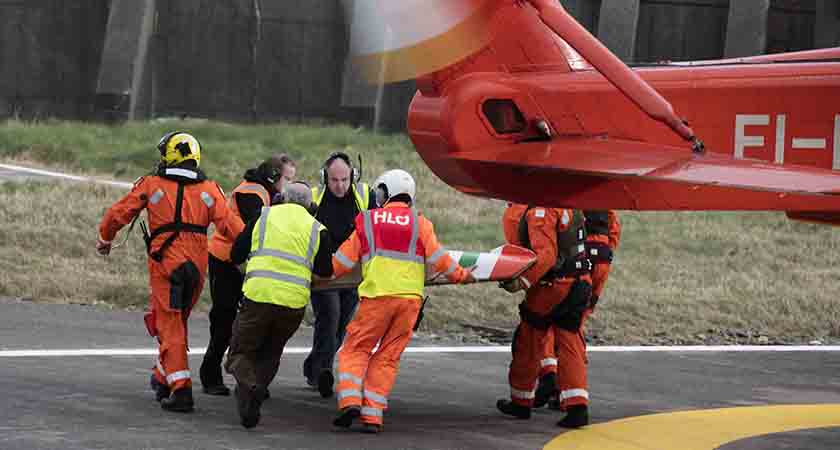THE search and rescue helicopter missing off the West coast of Ireland had 'contact' with rocks before it disappeared, investigators have said.
The Chief Inspector of Air Accidents, Mr. Jurgen Whyte, and Investigator-in-Charge, Mr. Paul Farrell gave a statement about the continuing investigation into the missing R116 helicopter, which lost contact off Black Sod Bay, Co. Mayo on March 14.
Contact with the Dublin helicopter was lost around 1am and a major search operation commenced.
"The Air Accident Investigation Unit (AAIU) has visited Black Rock Light House, on the approach to Blacksod bay, which is close to the last recorded position of the helicopter," a statement read.
"Some helicopter wreckage has been recovered from the general area of Black Rock Light House. This wreckage is primarily from the tail area of the helicopter.
"At this early stage in the investigation it is not possible to be definitive about the exact nature of damage to the recovered wreckage or indeed the circumstances of the accident.
"However, there appears to be marks on some of the recovered wreckage which are consistent with the tail of the aircraft contacting rocky surfaces on the Western end of Blackrock.
"The investigation has not yet definitively identified the initial point of impact."
 The debris of helicopter SAR 116 will be sent to the AAIU wreckage facility in Meath for detailed examination. (Picture: Eamonn Farrell/RollingNews.ie
The debris of helicopter SAR 116 will be sent to the AAIU wreckage facility in Meath for detailed examination. (Picture: Eamonn Farrell/RollingNews.ieThe AAIU also said they are "anxious" to recover and examine as much wreckage as possible, and in particular to recover the combined voice and flight data recorder, the black box.
The signal from the black box is still detected and will be the focus of further investigation.
Following the disappearance of the helicopter, the body of Captain Dara Fitzpatrick was found on March 14, and flown to Mayo University Hospital where she was formally pronounced dead.
At the time of her death, she was 45, and had served with the Irish Coast Guard for 20 years.
The remaining three crew members, Captain Mark Duffy and winchmen Paul Ormsby and Ciarán Smith, are still missing.
 Captain Mark Duffy as well as winchmen Paul Ormsby and Ciarán Smith, above left, are still missing from SAR helicopter 116, but Capt Dara Fitzpatrick, right, was recovered last week. (Picture: Rollingnews/EMEA CHC)
Captain Mark Duffy as well as winchmen Paul Ormsby and Ciarán Smith, above left, are still missing from SAR helicopter 116, but Capt Dara Fitzpatrick, right, was recovered last week. (Picture: Rollingnews/EMEA CHC)"Equipment aboard surface search vessels has detected a signal which is believed to be from the underwater locator beacon attached to the aircraft’s black box," the AAIU said.
"This signal points toward an area which will be the focus of further, multi-agency investigation activities at the earliest opportunity, subject to weather."
A "significant amount" of wreckage has been recovered from the sea and this has been logged and will be brought to the AAIU wreckage facility in Gormanston, Co. Meath, for detailed examination.
The investigation has involved members of An Garda Síochána, Coast Guard, Irish Air Corps, the Irish Marine Institute, as well as many local people and agencies with the primary objective of locating and recovering the missing crew members.

